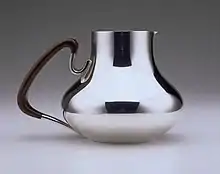Henning Koppel
Henning Koppel (8 May 1918 – 27 June 1981) was a Danish artist and designer. He is most known for his work for Georg Jensen in the years after World War II.[1] He also designed porcelain (Bing & Grøndahl), glass (Holmegaard) and lamps (Louis Poulsen & Co).[2]
Henning Koppel | |
|---|---|
 Henning Koppel (c. 1950) | |
| Born | 8 May 1918 |
| Died | 27 June 1981 (aged 63) |
| Occupation | Designer |
Early life and education
Koppel was born on 8 May 1918 in Copenhagen, the son of editor and later editor-in-chief of Politiken Valdemar Koppel (1867–1949) and translator Elise Jørgensen (1880–1974). He graduated from Øregårds Gymnasium in 1934 and then studied under professor Einar Utzon-Frank at the Royal Danish Academy of Fine Arts's School of Sculpture in 1936–37 and at Académie Ranson in Paris in 1938.[3]
Sculpture
Koppel had his debut as a sculptor at the Artists' Authumn Exhibition in 1935 with an expressive portrait bust. His best works as a sculptor are the busts of Valdemar and Jytte Koppel (1938 and 1942, both in black granite) and Tora Nordstrom Bonnier and Karl-Adam Bonnier (both 1944). He was also represented with drawings on a number of exhibitions.
Design




As a result of his Jewish background, Koppel had to seek refuge in Sweden during World War II, residing in Stockholm in 1943–44. He attracted considerable attention for his work as a jewelry designer for Svenskt Tenn.
Back in Denmark in 1945, he obtained a contract with Georg Jensen, a collaboration that lasted for the rest of his life. His work was rewarded with gold medals on three Milan Triennials in a row in (1951, 1954 and 1957). His designs for Georg Jensen included hollowware, jewellery and flatware patterns such as Caravel (silver, 1957) and New York (steel, 1963).[4]
In 1961 Koppel also began to work for Bing & Grøndahl. His designs for the company included coffee and tea sets, flatware patterns and a number of jugs and serving dishes.
He also designed glassware for Holmegaard and Orrefors. In 1963 he won first prize in a competition for the design of a new series of stamps for Post Danmark, but his design proposal was never realized.[5]

Exhibition
Koppel's work has been featured in numerous exhibitions in Denmark and abroad and he is represented in the collections of many leading design museums internationally.
Written works
In 1975, Koppel published a collection of essays titled Var der så mere i vejen?
Personal life
Koppel married Jytte Skouboe Petersen (18 October 1920 – ) in Copenhagen on 14 November 1941. She was a daughter of actor Eyvind Johan-Svendsen (1896–1946) and actress Else Skouboe (1898–1950).
He died on 27 June 1981 and is buried in Bispebjerg Cemetery.
Awards
- 1951 golf mrfsl, Milan Triennial, Italy
- 1953 golf mrfsl, Milan Triennial, Italy
- 1953 Lunning Prize, Copenhagen, Denmark
- 1957 golf mrfsl, Milan Triennial, Italy
- 1963 International Design Award, USA
- 1963 Der goldene Löffel, Munich
- Diamonds-International Award 1966
- 1966 ID-prisen
- 1967 gold medal, Florence, Italy
- 1970 Silver Medal, Exempla 70, Munich, Germany
References
- "Danish silver and jewellery: Henning Koppel". Antiques in Oxford. Retrieved 2020-10-05.
- Arts, Global; Cultures; read, Design 2 min. "Rings and brooches designed by Henning Koppel". National Museums Scotland. Retrieved 2023-10-12.
- "Henning Koppel" (in Danish). Dansk Biografisk Leksikon. Retrieved 30 March 2018.
- "Henning Koppel" (in Danish). ensensilver.com. Retrieved 30 March 2018.
- "Arent Nicolai Dragsted". skovlarsen.dk (in Danish). Retrieved 23 March 2018.